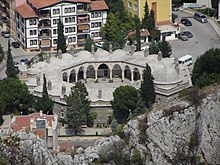Amasya
[1] Amasya stands in the mountains above the Black Sea (Karadeniz) coast, set apart from the rest of Anatolia in a narrow valley along the banks of the Yeşilırmak River.Located in a narrow cleft of the Yeşilırmak (Iris) river, it has a history of 7,500 years with many traces still evident today.With its Ottoman-period wooden houses and the tombs of the Pontus kings carved into the cliffs overhead, Amasya is attractive to visitors.[citation needed] Archaeological research shows that Amasya was first settled by the Hittites and subsequently by Phrygians, Cimmerians, Lydians, Greeks, Persians, and Armenians.[citation needed] An independent Pontic kingdom with its capital at Amaseia was established by the Persian Mithridatic dynasty at the end of the 4th century BC, in the wake of Alexander's conquests.Today, there are prominent ruins including the royal tombs of Pontus in the rocks above the riverbank in the centre of the city.[citation needed] Amaseia was captured by a force led by the Roman Lucullus in 70 BC from Armenia and was quickly made a free city and administrative center of his new province of Bithynia and Pontus by Pompey.Ursel had, according to the book, looted and pillaged the Eastern provinces of the Byzantine Empire until the at-the-time General Alexios convinced Tutach to capture him.to Tutach for the capture of Ursel, however Alexios had no cash to give and the Emperor was unable to fund it, so he attempted to raise money from the people of Amaseia, however this caused serious unrest.[citation needed] In 2013, a 24-square-meter Christian mosaic belonging to the floor of a chapel was discovered, near a site where an illegal archaeological dig had been attempted.[8] Under the Seljuks and the Ilkhan, the city became a centre of Islamic culture and produced some notable individuals such as Yaqut al-Musta'simi (1221–1298) calligrapher and secretary of the last Abbasid caliph who was a Greek native of Amasya.[8][10] After the disastrous Battle of Ankara in 1402, Mehmed I fled to Amasya, which (along with nearby Tokat) became his main residence and stronghold during the Ottoman Interregnum.[citation needed] Suleiman the Magnificent often stayed in the city, and even received the Habsburg ambassador Ogier Ghiselin de Busbecq there.When the supposed victim was discovered to still be alive, Sultan Suleiman the Magnificent ordered that all accusations regarding religious rituals should be judged under "royal" and not local court.Many Armenian civilians fleeing the attacks sought refuge at the American missionary school Anatolia College, located in Merzifon outside Amasya.[16] As capital of the Late Roman province of Helenopontus, it also became its Metropolitan Archbishopric and included the suffragans of Amisus, Andrapa, Euchaitae, Ibora, Sinope, Zaliche and Zela.The Orthodox metropolis of Amasea was active until the Population exchange between Greece and Turkey (1923) and in 1922 counted c. 40,000 Christians, 20,000 of them being Greek speakers.[17] Rome suppressed the see formally c. 1600, but immediately transformed it into a titular archbishopric Amasea, of the highest (Metropolitan) rank, which has had the following archiepiscopal incumbents: On 1742.02.15 it was united (as a mere title) with the residential Diocese of Pavia (Italy).It is vacant for decades, having had the following archiepiscopal incumbents since: In its Turkish version, this classic tale of oriental folklore is held to have taken place in Amasya.The nearby mountain Ferhat is named for Farhad (Turkish spelling Ferhat), the hero of the legend, who for love of the princess Shirin (Turkish spelling Şirin) tried to win her father's favour and permission by tunnelling through the mountain to bring spring water to his palace.The city is not so developed industrial terms, but is attractive and well-preserved, especially when sitting by the river, which has a particular mystique on a winter evening when fog fills the valley.The 19th century Hazeranlar Mansion has been restored perfectly and now it is of great interest with an art gallery on its first floor and an ethnographical museum on the second.Amasya is a city on the road of the Europe and Iran international way and it connects Samsun port to the interior regions of the country.









Panorama of Amasya





AmasraAmasia, ShirakMunicipalityAmasya CastleTurkeyProvinceAmasyaDistrictTime zoneBlack Sea RegionAmasya ProvinceAmasya DistrictBlack SeaYeşilırmakStraboAmirdovlat AmasiatsiPontusOttomanOttoman sultansMurad ISelim IOttoman housesYeşilırmak RiverPonticAmazonsArmenianOttoman TurkishHittitesPhrygiansCimmeriansLydiansGreeksPersiansArmeniansPontic kingdomPersianMithridatic dynastyAlexanderroyal tombs of PontusLucullusArmeniaBithyniaPompeyGalatiaTrajanCappadociametropolisRoman EmpireDiocletianEast Roman EmpireByzantine EmpireAlexiadEmperor Alexios I KomnenosTheodore of AmaseaAsterius of AmaseaOttoman architectureTurkmenDanishmendSeljukKilij Arslan IIRukn ad-Din Suleiman ShahMongolIlkhanateMesud IIYaqut al-Musta'simiEretnidHadji Shadgeldi PashaKadi Burhan al-Dinmounting pressureBayezid IMehmed IBattle of AnkaraOttoman InterregnumRûm EyaletBayezid IIMurat IIISuleiman the MagnificentHabsburgOgier Ghiselin de Busbecqblood libelChristianPeace of AmasyamilletMedreseOttoman EmpireAtatürkTurkish War of IndependenceAmasya CircularSivas CongressErzurumErzurum CongressWorld War IAnatolia CollegeMerzifonThessalonikipopulation exchange between Greece and TurkeyAmasya trialsTurkish National MovementEastern Roman EmpireRoman provinceHelenopontusAmisusAndrapaSinopeZalicheEcumenical Patriarchate of ConstantinopleTurkic migrationsGermanos KaravangelisEastern Orthodox ChurchCatholic Churchtitular seetitular archbishopric(Giovanni) Battista AgucchiaFausto PoliCardinal-PriestOrvietoEgidio ColonnaCassinese Benedictine CongregationTitular Latin Patriarch of JerusalemAlbengaMolfettaFerdinando d'AddaJames II of EnglandS. ClementeSacred Congregation of RitesCardinal-Bishop


